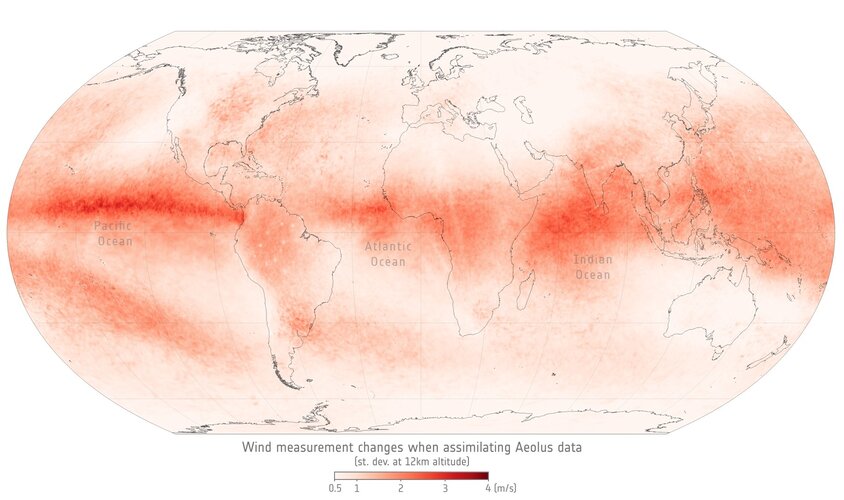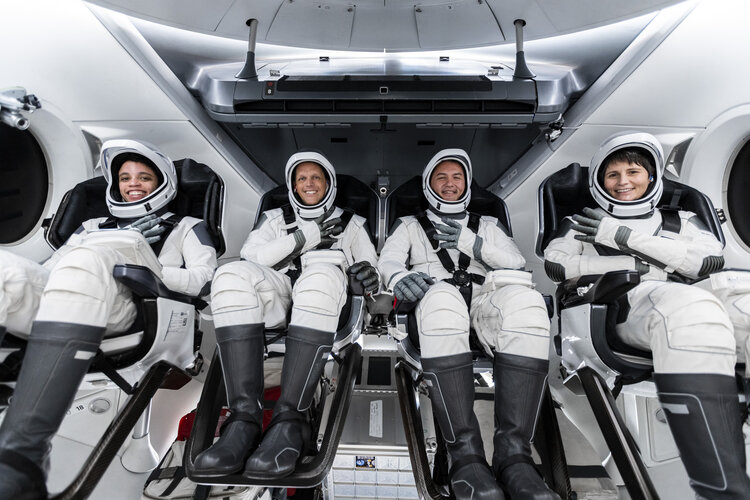Keeper of the winds shines on
Tuesday, 26 April 2022 07:00
Launched back in 2018, Aeolus has outlived its 36-month in-orbit design life – but going above and beyond, it continues to deliver excellent data. This shows that there’s life yet in the satellite, meaning ESA’s wind mission is now expected to continue shining a light on the wind for another year.
Watch live: Crew-4 liftoff to the International Space Station
Tuesday, 26 April 2022 07:00
Tune in to ESA Web TV this Wednesday 27 April to watch ESA astronaut Samantha Cristoforetti begin her journey to the International Space Station. Launch is scheduled at 09:52 CEST (07:52 GMT), and live streaming will start at 06:00 CEST (05:00 GMT).
Space Blocs: The future of international cooperation in space
Tuesday, 26 April 2022 06:33 Even during times of conflict on the ground, space has historically been an arena of collaboration among nations. But trends in the past decade suggest that the nature of cooperation in space is shifting, and fallout from Russia's invasion of Ukraine has highlighted these changes.
I'm an international relations scholar who studies power distributions in space - who the main players are, wh
Even during times of conflict on the ground, space has historically been an arena of collaboration among nations. But trends in the past decade suggest that the nature of cooperation in space is shifting, and fallout from Russia's invasion of Ukraine has highlighted these changes.
I'm an international relations scholar who studies power distributions in space - who the main players are, wh Moody's and Planet Labs form strategic relationship for asset verification services
Tuesday, 26 April 2022 06:33 Planet Labs and Moody's have entered into an agreement to explore and address the growing demand for assessing and monitoring solutions on Environmental, Social, and Governance (ESG) risks.
The companies will look to address how Planet's high-cadence geospatial data and Moody's market-leading entity data, methodologies, and products can be leveraged to further refine Moody's existing offer
Planet Labs and Moody's have entered into an agreement to explore and address the growing demand for assessing and monitoring solutions on Environmental, Social, and Governance (ESG) risks.
The companies will look to address how Planet's high-cadence geospatial data and Moody's market-leading entity data, methodologies, and products can be leveraged to further refine Moody's existing offer China mulls mission on far side of moon
Tuesday, 26 April 2022 06:33 Chinese scientists and engineers are considering sending a robotic probe to collect dust and rocks from the far side of the moon, an ambitious endeavor that would likely be a world first, according to a senior space agency official.
Wu Yanhua, deputy director of the China National Space Administration, said the United States, Russia and China have brought lunar substances back to Earth, bu
Chinese scientists and engineers are considering sending a robotic probe to collect dust and rocks from the far side of the moon, an ambitious endeavor that would likely be a world first, according to a senior space agency official.
Wu Yanhua, deputy director of the China National Space Administration, said the United States, Russia and China have brought lunar substances back to Earth, bu Kleos announces new Mission-as-a-Service offering
Tuesday, 26 April 2022 06:33 Kleos Space has announced a new product offering, access to dedicated, taskable RF Reconnaissance satellite capacity i.e. a Mission-as-a-Service (MaaS). Kleos says it is diversifying its business model to include Mission-as-a-Service (MaaS) capability, providing customers with exclusive access to Kleos' dedicated, in-orbit radio frequency reconnaissance satellite clusters for fixed periods of ti
Kleos Space has announced a new product offering, access to dedicated, taskable RF Reconnaissance satellite capacity i.e. a Mission-as-a-Service (MaaS). Kleos says it is diversifying its business model to include Mission-as-a-Service (MaaS) capability, providing customers with exclusive access to Kleos' dedicated, in-orbit radio frequency reconnaissance satellite clusters for fixed periods of ti BlackSky upgrades site monitoring with enhanced analytics and imaging capabilities
Tuesday, 26 April 2022 06:33 BlackSky (NYSE: BKSY) upgraded its site monitoring capabilities with new analytics and imaging features to meet customers' varied needs for information gathering and intelligence across geographically diverse environments.
"BlackSky released new imaging and analysis upgrades that, when combined with our high-revisit satellite imaging capabilities, will make monitoring the world's most crit
BlackSky (NYSE: BKSY) upgraded its site monitoring capabilities with new analytics and imaging features to meet customers' varied needs for information gathering and intelligence across geographically diverse environments.
"BlackSky released new imaging and analysis upgrades that, when combined with our high-revisit satellite imaging capabilities, will make monitoring the world's most crit Time might not exist say physicists and philosophers
Tuesday, 26 April 2022 06:33 Does time exist? The answer to this question may seem obvious: of course it does! Just look at a calendar or a clock.
But developments in physics suggest the non-existence of time is an open possibility, and one that we should take seriously.
How can that be, and what would it mean? It'll take a little while to explain, but don't worry: even if time doesn't exist, our lives will go o
Does time exist? The answer to this question may seem obvious: of course it does! Just look at a calendar or a clock.
But developments in physics suggest the non-existence of time is an open possibility, and one that we should take seriously.
How can that be, and what would it mean? It'll take a little while to explain, but don't worry: even if time doesn't exist, our lives will go o Penn State to lead study of radiation effects on electronics
Tuesday, 26 April 2022 06:33 Electronics employing wide bandgap semiconductors promise better resistance against radiation damage over conventional silicon-based electronics, according to a newly funded national collaboration led by Penn State. To better predict and mitigate radiation-induced damage of wide bandgap semiconductors, the U.S. Department of Defense awarded the team a five-year, $7.5 million Defense Multidiscipl
Electronics employing wide bandgap semiconductors promise better resistance against radiation damage over conventional silicon-based electronics, according to a newly funded national collaboration led by Penn State. To better predict and mitigate radiation-induced damage of wide bandgap semiconductors, the U.S. Department of Defense awarded the team a five-year, $7.5 million Defense Multidiscipl NRO plans for immediate and long-term acquisition of commercial satellite data
Tuesday, 26 April 2022 03:10
The National Reconnaissance Office has issued contracts to satisfy immediate needs for commercial satellite data, while drafting requirements to bring commercial capabilities into an integrated architecture that includes classified U.S. government systems.
The post NRO plans for immediate and long-term acquisition of commercial satellite data appeared first on SpaceNews.
Ax-1 splashes down off Florida coast, ending first private mission to ISS
Tuesday, 26 April 2022 03:00 After nearly a week of delays, the first-ever all private astronaut mission to the International Space Station came to an end Monday, with the crew splashing down in the early afternoon off the coast of Florida.
"Dragon Endeavour has returned, bringing the Axiom-1 crew home," SpaceX officials announced on the livestream. "On behalf of the entire SpaceX team, welcome back to planet Earth
After nearly a week of delays, the first-ever all private astronaut mission to the International Space Station came to an end Monday, with the crew splashing down in the early afternoon off the coast of Florida.
"Dragon Endeavour has returned, bringing the Axiom-1 crew home," SpaceX officials announced on the livestream. "On behalf of the entire SpaceX team, welcome back to planet Earth NASA extends exploration for 8 planetary science missions
Tuesday, 26 April 2022 03:00 Following a thorough evaluation, NASA has extended the planetary science missions of eight of its spacecraft due to their scientific productivity and potential to deepen our knowledge and understanding of the solar system and beyond.
The missions - Mars Odyssey, Mars Reconnaissance Orbiter, MAVEN, Mars Science Laboratory (Curiosity rover), InSight lander, Lunar Reconnaissance Orbiter, OSIR
Following a thorough evaluation, NASA has extended the planetary science missions of eight of its spacecraft due to their scientific productivity and potential to deepen our knowledge and understanding of the solar system and beyond.
The missions - Mars Odyssey, Mars Reconnaissance Orbiter, MAVEN, Mars Science Laboratory (Curiosity rover), InSight lander, Lunar Reconnaissance Orbiter, OSIR IHI AEROSPACE received its first commercial launch service order
Tuesday, 26 April 2022 03:00 IHI Co., Ltd (IA) received order for launching the small SAR satellites(*1) owned by Institute for Q-Shu Pioneers of Space, Inc. (hereinafter 'iQPS'). IA and iQPS signed the contract for launch service of QPS-SAR-3 and QPS-SAR-4 (*2) on April 18, 2022.
QPS-SAR-3 and QPS-SAR-4 are under manufacturing by iQPS with more than 25 partner companies in northern Kyushu and other parts of Japan. Tw
IHI Co., Ltd (IA) received order for launching the small SAR satellites(*1) owned by Institute for Q-Shu Pioneers of Space, Inc. (hereinafter 'iQPS'). IA and iQPS signed the contract for launch service of QPS-SAR-3 and QPS-SAR-4 (*2) on April 18, 2022.
QPS-SAR-3 and QPS-SAR-4 are under manufacturing by iQPS with more than 25 partner companies in northern Kyushu and other parts of Japan. Tw Artemis I, Crew-4, and Starlink Rockets on the Pad
Tuesday, 26 April 2022 03:00 A SpaceX Falcon 9 rocket carrying a batch of the company's Starlink internet satellites lifts off from Launch Complex 40 at Cape Canaveral Space Force Station in Florida, on April 21, 2022.
On the right, NASA's Space Launch System rocket with the Orion spacecraft aboard sits atop a mobile launcher at Launch Complex 39B at Kennedy Space Center, wh
A SpaceX Falcon 9 rocket carrying a batch of the company's Starlink internet satellites lifts off from Launch Complex 40 at Cape Canaveral Space Force Station in Florida, on April 21, 2022.
On the right, NASA's Space Launch System rocket with the Orion spacecraft aboard sits atop a mobile launcher at Launch Complex 39B at Kennedy Space Center, wh Rad Rock Rumblings Sols 3453-3555
Tuesday, 26 April 2022 03:00 Entering the weekend, we have a few more 'rad' rocks we'd like to get some science on before we drive farther away from the Greenheugh pediment and begin our journey again up Mt. Sharp.
Starting on sol 3453, we break out our arm instruments for contact science with APXS and MAHLI on "Rumblings," a rock with an interesting knobby texture, followed by a delta over to "Delting," a flat area o
Entering the weekend, we have a few more 'rad' rocks we'd like to get some science on before we drive farther away from the Greenheugh pediment and begin our journey again up Mt. Sharp.
Starting on sol 3453, we break out our arm instruments for contact science with APXS and MAHLI on "Rumblings," a rock with an interesting knobby texture, followed by a delta over to "Delting," a flat area o 